Four Art Mediums – Four Projects in Progress
Many Mediums – Many Versions of Style
I am not overly excited about the word “focus.” I have one artistic vision, but I don’t limit art mediums much. I think my style is evident in whatever I do. This year I have allowed myself to stretch even further than before, and embrace the challenges that different art mediums bring to me.
Cross Stitching – A Cat in Progress
Do you remember this cat from the course Magical Inkdom? In April, I asked what drawing should be my next cross-stitch design, and you voted for the cat.
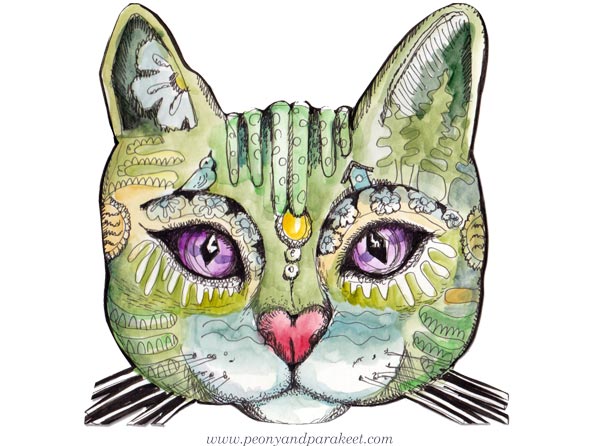
I have now made a design based on the drawing. To make sure that there are no errors in the chart, I have been stitching it myself first, going through every detail. The stitched piece is nearly finished as you can see in the picture!
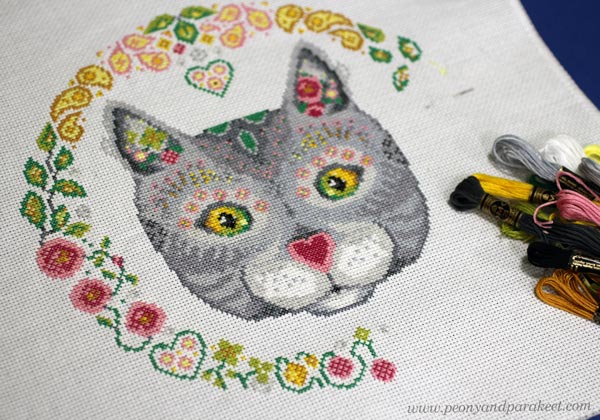
While stitching, I came up with the idea of including different colored versions of the cat to the final instructions. Maybe a black cat at least. What do you think?
I hope to get the chart for sale before December. This is a project I have been working on in the evenings.
Oil Painting – A Big Painting in Progress
My main medium – oils – were on a break for a few months so it was really nice to get a new painting started in July.
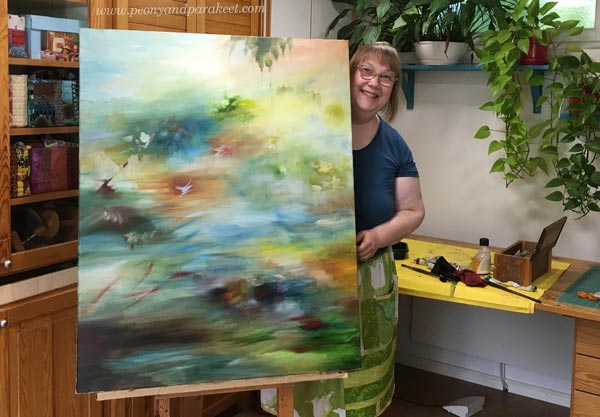
I work slowly from one layer to another, letting the painting dry between the sessions. Here’s where I am now.
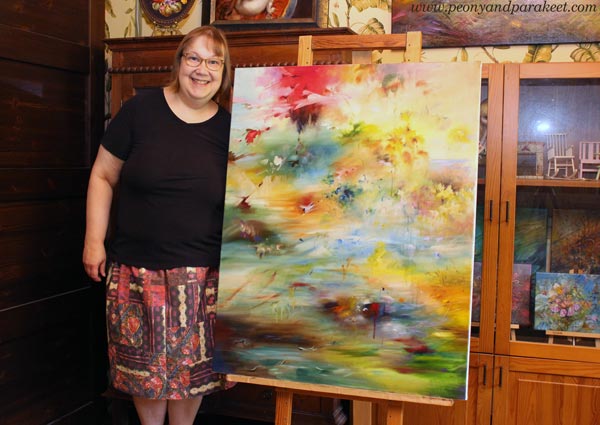
In the photo above, I am wearing a patchwork skirt sewed from the fabrics that I designed many years ago. The motifs are based on my drawings and knits.
I have still quite a lot of work to do with the painting. I hope to get it finished in October.
Digital Art – A Virtual Artwork in Progress
Transferring my painting style to digital three-dimensional modelshas been a year-long project. Watch this video to see what I made last spring for the project. The project is now coming to an end in September. I still have some things to adjust and add, but most of the things have been done.
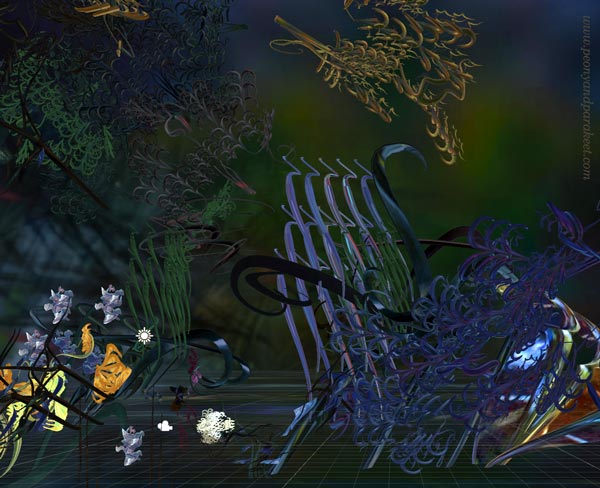
Sadly, the photos are nowhere near the overall experience that can be watched with VR glasses.
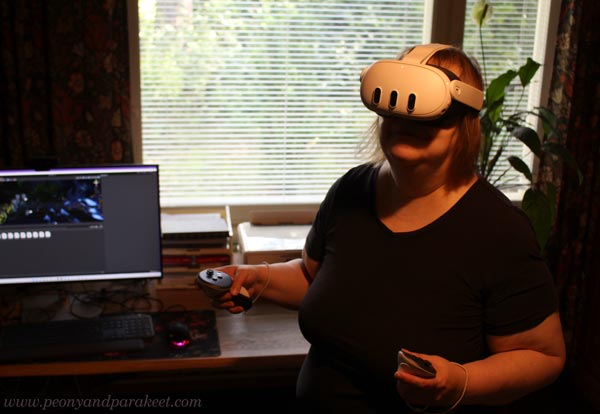
There’s a lot of movement. but also interaction: a user can move around, open a flower, create new objects etc.
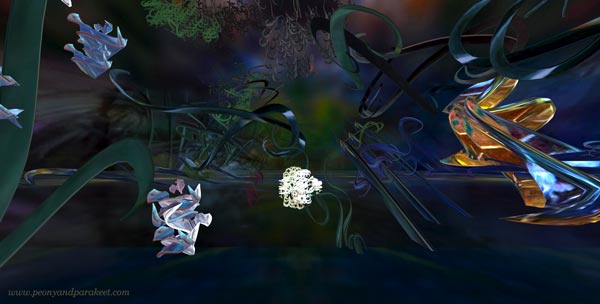
Still images are not the same as seeing everything in moving 3D, but at least you get a glimpse of the atmosphere. I will make a separate video in September where I will share more of this project.
Watercolor Pencils – A New Course in Progress!

I am super-excited to announce that a new course will begin in September 16, and the registration will open next week! The course is called Joyful Coloring, and it’s about using watercolor pencils for colorful happy art.

More about the course next week. I hope you will join!
Summer Break in July!
Dearest Gentle Reader,
this is my summer letter to you.

Last weekend, I finished watching the new season of the Bridgerton drama and then went to look at my little meadow in the back garden.
My husband sowed the seeds this spring and watered them regularly. And now, the meadow is a delightful little spot, a blooming salad as some laughingly call the flower beds that are mixed and wild-looking.

While I have watched women dance and the meadow grow, I have realized that I need a summer break from blogging. I want to use that time to sow some creative ideas and nurture them well. It will produce flowers for you later this year, I promise.
So, this blog is on a break for July, but to make it up to you,
all classes are 15% OFF for the whole month.
Let’s keep creating!
Päivi
Finishing a Watercolor Painting
This week, I have a video about finishing a watercolor painting.

See more pics on the Finnish art store Taiko’s website!
Painting Freely and The Challenge of Finishing
I paint watercolors freely without models or reference photos. It’s exciting to see what appears on the paper and to examine random spots trying to find flowers and plants, which are my favorite subjects. I believe that if I manage to create favorable conditions, the plants will start to grow naturally on paper.

When painting flowers freely without references, it’s easy to omit the details. But I think that the details make the finished look. Everything doesn’t have to be sharp and intricate but focus on those parts that you want to catch the viewer’s eye.
Making a Color Chart
My watercolor set has colors from many different manufacturers. I use artist-quality colors and always as pans. If I buy a tube, I’ll squeeze the paint into the pan. I like to use a color chart. The colors look darker when wet and on the pans as well. And there are differences in how pigments behave.

My grid follows the order of the pans and I add the names of the pigments below the color samples. A part of the colors are in a separate box waiting for their turn to get to the 36-pan set. I make notes on them at the end of the chart. The color chart prevents me from buying several similar pans (that happened too many times before I made one!) and helps with memorizing which colors are my favorites.
Start Freely – Finish Slowly!
There are watercolor painters who wet the paper, draw a few brushstrokes on it and the painting is finished. I work on the same painting for several hours and slowly approach the result layer by layer. It requires patience, but on the other hand, I can always paint on fine-quality cotton paper because my approach is less experimental.
I love that the painting doesn’t immediately shout but first whispers timidly. Each painting is unique and I like to spend time getting to know it. In doing so, I will not only learn something about the painting or myself but about humanity and nature in general.
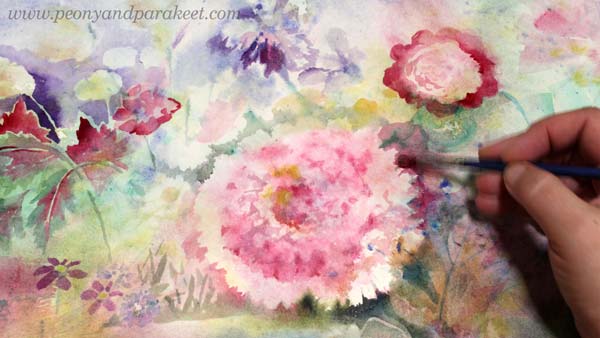
I want the result to look natural, although there is also a lot of decoration in my paintings. I love ornaments – swirls, decorative lines, and shapes, and my favorite historical style is Baroque. It is easy for me to see the luxury of baroque in plants. As a child, I imagined palaces and halls around me when walking in nature. Life in a remote small town in the 1970s was modest, but I got by with imagination.
Finishing a Watercolor Painting – Watch the Video!
In the video, I have footage from the finishing phase. There you can see that when proceeding little by little, you can add all kinds of things even in the final stages. It’s common for me that a shape is just a circle at first, but then I add notches to it and make it a leaf or a flower. Watch the video!
Freely Grown – Using Colored Pencils for Finishing
If you are new to watercolor painting, working with thin brushes can feel challenging. It’s then easier to use colored pencils for finishing a watercolor painting. I have a course called Freely Grown where you learn step-by-step how to make a layered watercolor painting and finish it with colored pencils. All this is done freely without models and by focusing on techniques, so your work has the same steps, but the result will be completely unique.

Freely Grown is now 15% OFF! >>Buy Now!
The sale ends on July 31st, 2024, at midnight PDT.
Drawing Sceneries with Watercolor Pencils
This week, I have a fun drawing idea: fill a paper with many small sceneries!

For this project, I have used watercolor pencils and Fabriano Accademia drawing paper (size: A4). The paper is very nice with colored pencils and goes well with watercolor pencils too.
Inspiration for Drawing Sceneries
Creating mini-sceneries is easy when you start playing with the scale. Think about a bumblebee – how it first flies over fields admiring the view and then finds a mini-world inside a flower.
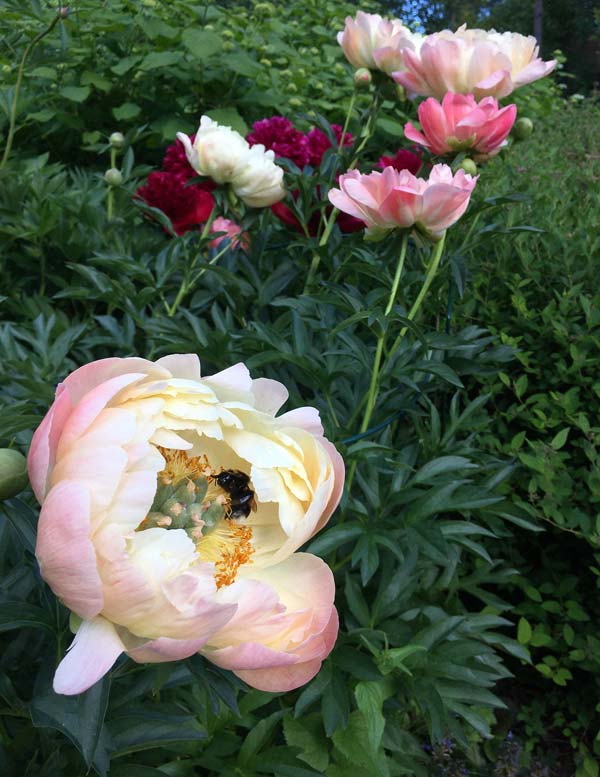
Your mind can be a busy bee, collecting a variety of ideas – big and small.

Your hand can then pick some of those ideas and put them into one picture like it would be a treasured collection in a secret museum. “Faberge eggs,” said my husband when I showed my picture to him.
Watercolor Pencils
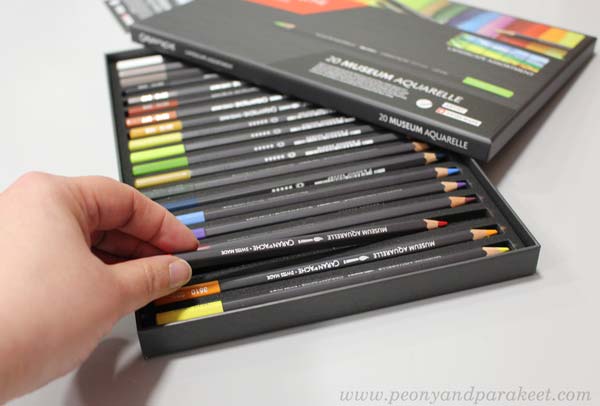
I often use regular colored pencils but slowly I have become interested in watercolor pencils too. I have had a few Caran d’Ache Museum Aquarelle pencils for a while and I love their quality – vivid colors, lovely to hold, and work well without water too. A couple of weeks ago, I bought 20 landscape colors to accompany what I already have.
Mini-Sceneries – Start Here!
Start your collection by picking a circle template, for example, a lid. Draw circles so that they overlap partially. Put one idea into one circle and color each of the circles separately.

This can be a “one in a day” project. Take your time to focus on each circle.
Watercolor Pencils in Use
Watercolor pencils are great for quickly filling larger areas. Color the area lightly and then add water over the colored area.

Let dry before adding a new layer on the top.
Drawing Sceneries – Playing with Styles
My favorite thing is to combine nature-related ideas such as landscapes and flowers with decorative motifs. I like to draw dots, other simple shapes, and lines so that they form frames and ornaments.

In this project, the circles are nature-related while the background has a more ornamental approach.

When you keep the background unified, you can use many styles in one piece. One paper then becomes a diary where anything handmade looks great together because it’s made by one hand and one mind.
Drawing in Ornamental Style

This project is another variation of the earlier blog post: Colored Pencils – Ornamental Approach. If you have taken the course Intuitive Coloring, would you be interested in creating something like this on a course next?